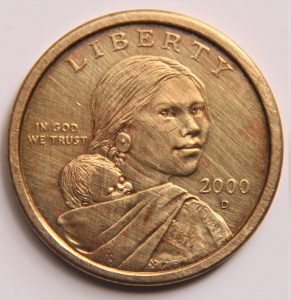 Continuing where I left off in the morning post…
Continuing where I left off in the morning post…
2015
Commemorates the contributions of the Kahnawake Mohawk and Mohawk Akwesasne communities to “high iron” construction work and the building of New York City skyscrapers. [The tradition of Mohawk high iron working dates to 1886, when the Dominion Bridge Company started a bridge from the Kahnawake Mohawk community across the St. Lawrence River.]
![Designed by Ronald D. Sanders, engraved by Phebe Hemphill, image created by the U.S. Mint [Public domain]](https://www.motleymoose.com/wp-content/uploads/2019/11/2015_Native_American_dollar_reverse-300x300.jpg)
Commemorates the contributions of the Native American Code Talkers in World War I and World War II. [Native languages came to play an increasingly vital role in the U.S. war effort in both World War I and II.]
![United States Mint [Public domain]](https://www.motleymoose.com/wp-content/uploads/2019/11/2016_Native_American_Coin-300x300.jpg)
Sequoyah, inventor of the Cherokee Syllabary. [Sequoyah adapted writing to the Cherokee language by devising symbols for each syllable.]
![United States Mint [Public domain]](https://www.motleymoose.com/wp-content/uploads/2019/11/2017_Native_American_Dollar_Reverse-300x300.png)
James Francis “Jim” Thorpe (1888-1953) [Born near Prague, Oklahoma, in what was then Indian Territory. Raised in the Sac and Fox tribe, he was given the native name Wa-Tho-Huk, meaning “Bright Path.” Jim Thorpe became possibly the most versatile natural athlete of the early 20th century.]
![United States Mint [Public domain]](https://www.motleymoose.com/wp-content/uploads/2019/11/2018_Native_American_Dollar_Reverse-300x300.jpg)
2019
American Indians in the Space Program [Native Americans have been on the modern frontier of space flight since the beginning of NASA. ]
![United States Mint [Public domain]](https://www.motleymoose.com/wp-content/uploads/2019/11/512px-2019_Native_American_Dollar_Reverse-300x300.jpg)
And yes, there is a 2020 Native coin coming out, but I think I’m going to write about the featured Native at a later date. She just happens to be one of Chelsea Clinton’s gutsy women, so her story will be told in a SHEnanigans post in the near future.

Thank you and the more I checked the links the more I could see why you didn’t want to base your “history” on this governmental source. The Code Talkers always get my attention. The evil irony – right up there with drafting Japanese-Americans from internment camps – of men who’d been beaten and abused for speaking their languages, of America’s all-too-successful insistence on eradicating Native languages, celebrating the life-saving work in WWII done by those who were determined enough to keep their languages…And to read in the link that there were supposedly well under a million Natives left in the 1940s – the myth of “gee we’re sorry but they’re extinct now” is still a meme. sigh. But thank you again for the posts and the links. {{{HUGS}}}